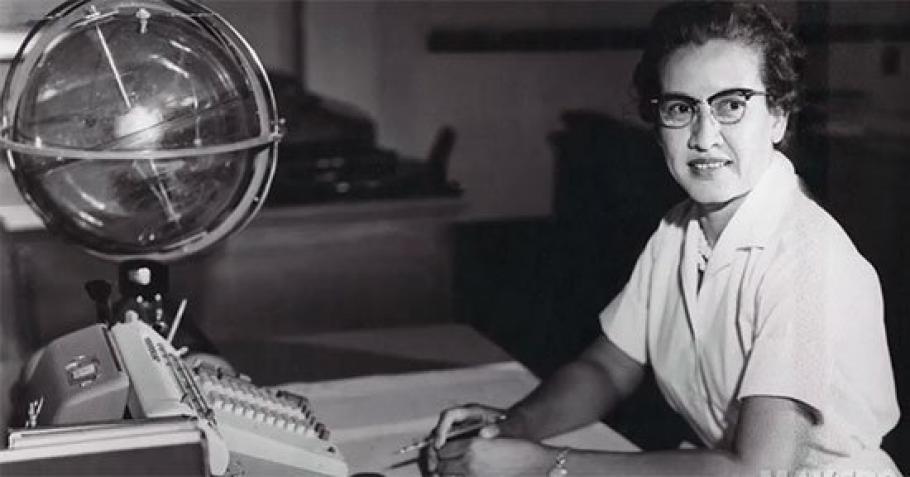Katherine Johnson’s name is now well known as one of NASA’s “hidden figures,” African American women whose pioneering work was a key part of our success in space. More people than ever before know about the contributions of Johnson and her colleagues, including Mary Jackson, Dorothy Vaughn and other “human computers.”

Johnson was born in White Sulfur Springs, West Virginia, in 1918. She was fascinated with numbers as a young person and highly intelligent—a freshman in high school by the time she was 10 years old, high school graduate at 14, and college graduate at 18. She graduated with honors from West Virginia State University in 1937 with degrees in mathematics and French. Her achievement with numbers continued, and she became one of the first African American graduate students at the University of West Virginia.
After working as a teacher, she went to work for the NACA (the forerunner of NASA), calculating results from the wind tunnel at Langley Research Center. She would go on to work for NASA. “Katherine excelled as a ‘human computer,’ and the flights of the first Americans in space relied on her calculations,” explained Dr. Ellen Stofan, “Even when NASA turned to electronic computers to tabulate trajectories, John Glenn now famously asked that Katherine personally recheck the calculations on his flight before climbing aboard Friendship 7.”
“Katherine, and countless unsung heroes just like her, carried the nation’s space program forward, despite pervasive opposition at all levels of society. Katherine went where her skills were needed—even if she wasn’t invited,” Stofan concluded.
Join us to discover the stories of two other women whose work and achievement, like Johnson’s, were hidden and untold for years—but who also played a key role in the success of the space program in the United States.
Christine Darden
Christine Darden was an aeronautical engineer at the NASA Langley Research Center. She was one of the leading NASA researchers in the sonic boom and its relation to supersonic and hypersonic aircraft.
She began her career at NASA in 1967 when she was hired as a “human computer” at the Langley Research Center. Prior to coming to NASA, Darden had earned a bachelor of science degree in mathematics from Hampton University in 1962 and a master’s of science from Virginia State College in 1967. (She went on to earn a PhD in engineering from George Washington University in 1983.)
According to NASA, “After wading through daily calculations for eight years, Darden approached her supervisor to ask why men, with the same educational background as her (a master of science in applied mathematics), were being hired as engineers. Impressed by her skills, her supervisor transferred her to the engineering section, where she was one of few female aerospace engineers at NASA Langley during that time.”
Darden’s first assignment was to write a computer program that modeled a sonic boom. This led to a 25-year career focused on sonic boom minimization. However, that is not all she contributed. “During her 40-year career at NASA, she led an advisory team composed of representatives from industrial manufacturers and academic institutions, became the deputy program manager of The TU-144 Experiments Program, an element of NASA’s High Speed Research Program; and, in 1999, she was appointed as the director in the Program Management Office of the Aerospace Performing Center where she was responsible for Langley research in air traffic management and other aeronautics programs managed at other NASA Centers,” NASA wrote in a post.
Patricia Cowings

A research psychologist in the Biomedical Division of Ames Research Center, Patricia Cowings investigated the psycho-physiological and biological problems experienced by astronauts in space in the early 1980s. The subject of her research, also known as space-sickness, is a real problem for many astronauts.
Cowings joined NASA in 1971, after earning a bachelor of arts degree from the State University of New York at Stoney Brook in 1970. (She would go on to earn a PhD in psychology from the University of California-Davis in 1973.)
Cowings’ tests induced sickness so she could learn how to combat the effects. Because astronaut training time is precious, she had to come up with a program that would take astronauts no longer than six hours to learn to control the sickness. Cowings designed a program of 12 half-hour sessions combining training with biofeedback. During training, she taught a subject to mentally evoke a sensation, like relaxation of muscles, to bring about desired physiological changes such as increased skin temperature or relaxed muscles. Cowings’ approach to biofeedback involved having to control as many as 26 physiological functions related to motion sickness. These included such things as heart rate, rate of respiration, and the flow of blood to the hands. Subjects learned to regulate these autonomic functions by watching them as they are displayed on an oscilloscope.





